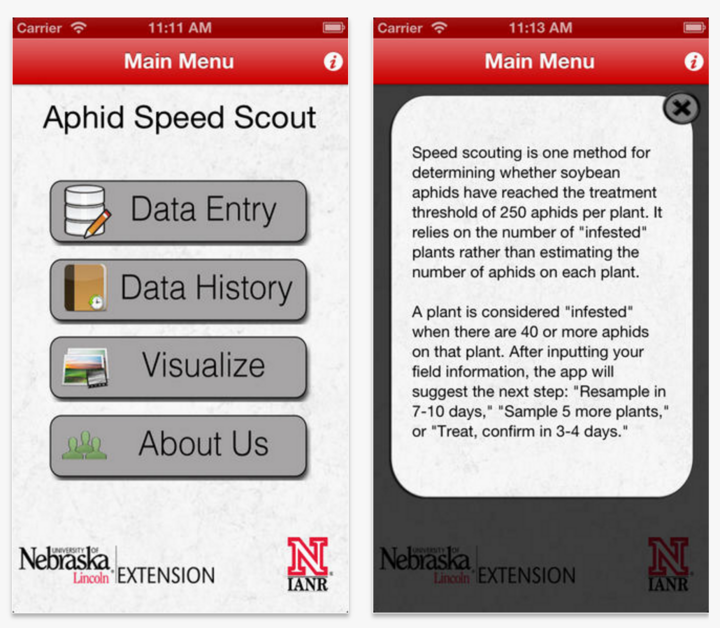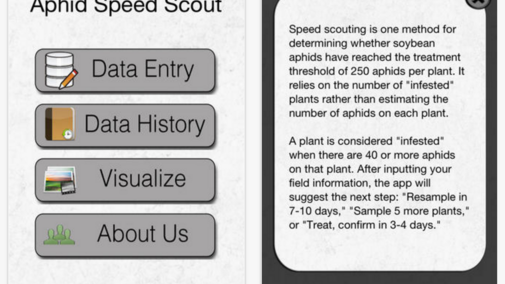The current recommended economic threshold for late vegetative through R5 stage soybeans is 250 aphids per plant with 80% of the plants infested and populations increasing. Depending on economic conditions, this generally gives you about five to seven days to schedule treatment before populations reach economically damaging levels.
If populations do not increase during these five to seven days, you may be able to eliminate or delay treatment. Determining if the aphid population is actively increasing requires several visits to the field. Factors favorable for aphid increase are
- relatively cool temperatures,
- plant stress (particularly drought),
- and lack of natural enemies.
Application Timing to Avoid Resurgence
Soybean aphids in Nebraska usually reach the economic threshold and require treatment in late July (rarely) through August, with a few fields requiring treatment earlier in July. Treatment during this period usually is enough to keep aphid populations from resurging because there is not enough time for populations to build-up before they would naturally leave the fields in late August and early September. The earlier a field is treated, the greater the chance that any surviving aphids can later reproduce or new aphids can repopulate the field.
And remember, insecticide treatment also kills many natural enemies, so any aphids that do re-infest a field are not constrained by predators and other natural controls. Even insecticides with a relatively long residual cannot last when insecticide treatment is done in early or mid-July, particularly during a year when aphid populations are thriving. There would also be no residual on new vegetative growth occurring after the treatment was applied. If one has to treat early, make sure to closely monitor the field until early September.
Also see:
- Although at Low Levels, Soybean Aphids Are in Northeast Nebraska
- Decision Making for Soybean Defoliating Insects
- Soybean Aphid Thresholds (MSU)
- UNL Soybean Defoliation Worksheet
Another practice that can result in aphid population resurgence is unwarranted insecticide treatment, either because fields were treated well before the threshold was met or fields were treated along with an herbicide (in some cases a fungicide), regardless of aphid presence. These treatments kill natural enemies and are usually done relatively early so there is plenty of time for aphids to resurge, or re-colonize a field.
Aphid populations below or even at the economic threshold do not cause yield loss, so treating before populations reach 250 aphids/plant only increases the probability of aphid resurgence. In addition, we have observed that many fields support a non-increasing, low population of aphids (e.g. less than 100 aphids/plant) through August. Treating these fields would be a waste of time and money.
Tank- mixing insecticides with glyphosate or other herbicides can be problematic because application methods for herbicides (e.g. lower pressures, large droplet producing nozzles) are not optimal for good insecticide efficacy. Tank-mixing with fungicides can be effective because application methods for fungicides and insecticides require high water pressure for adequate penetration and coverage, however, only conduct this practice if soybean aphid thresholds are met.
Scouting Methods
There are two methods to scout and determine if an insecticide treatment is warranted; a conventional scouting method using the 250 aphid/plant economic threshold and a speed scouting method.
The Conventional, 250 Aphids/Plant Method
- Begin scouting soybean fields once or twice a week in late June/early July. Check 20 to 30 randomly selected plants in various areas of each field. Aphids are most likely to concentrate at the very top of the plant, although they will move onto stems and within the canopy as populations grow and/or the plant reaches mid to late reproductive stages. If a tree line or woodlot is adjacent to the soybean field, make sure and include a few sampling locations near these areas. Soybean aphids are often found first in the parts of soybean fields near wooded areas.
- Counting aphids is not as difficult as it may at first seem. First, walk to a random spot in the field. Pull a plant and turn it upside down and give it a quick scan to see where the aphids are located. Get a feel for what 10 or 20 aphids look like and count by 10s or 20s.
- The current threshold for late vegetative through R5 stage soybean is 250 aphids/plant with 80% of the plants infested and populations increasing (see above for details). Thresholds for early R6 have yet to be determined, but are likely in the 400-500 aphids/plant range. Insecticide treatment done during or after mid-late R6 has not been documented to protect yield.
The Speed Scouting Method

- This method uses a spreadsheet adapted from a sampling plan developed by the University of Minnesota (Hodgson, E.W., E.C. Burkness, W.D. Hutchison, and D.W. Ragsdale. 2004. Enumerative and Binomial Sequential Sampling Plans for Soybean Aphid (Homoptera:Aphididae) in Soybean. J. of Econ. Entomol. 97(6): 2127-2136). It is different from conventional scouting in that it relies on the number of “infested” plants. Plants are considered “infested” when there are 40 or more aphids on a plant. The scout does not have to count or estimate the number of aphids on a plant to determine whether it has reached the threshold of 250 aphids per plant. One simply determines if a plant is infested and enters this in the spreadsheet. The spreadsheet then recommends further scouting or treatment options based on the number of “infested” plants in a given area.
- This tool is freely available as a web accessible UNL Extension Circular EC1582 Aphid Speed Scout to be used in the field on mobile devices (e.g. smart phone, computer, iPad) or as the free Aphid Speed Scout App available in the iTunes store.
General Management Guidelines
- Look for the presence of aphid natural enemies such as lady beetles, green lacewings, insidious flower bugs, aphid mummies, fuzzy aphids, and other insect predators. Predators and parasitoids may keep low or moderate aphid populations in check. One can often find soybean aphids by examining plants where lady beetles are observed.
- Take note of winged aphids or “broad-shouldered” nymphs. Nymphs with broad or squared- off shoulders will become winged adults. A magnifying glass is helpful to see the “broad-shouldered” nymphs, but the winged adults are easy to see with the naked eye. If the majority of aphids are winged or developing wings, the aphids may soon leave the field and treatment can be avoided.
- An insecticide treatment may still be of value if plants are covered with honeydew or sooty mold, or stunted, and aphids are still present at threshold levels, but the optimum time for treatment has passed.
- Good insecticide coverage and penetration is required for optimal control of soybean aphid because aphids feed on the undersides of the leaves and within the canopy. For ground application use high water volume (≥15 gallons/acre) and pressure (≥30 psi). Aerial application works best when high water volume is used (≥3 gallons/acre).
- Several insecticides are labeled for the soybean aphid. A list of registered insecticides, rates, preharvest intervals, etc., is available online. Pyrethroids have a relatively long residual, and work best at temperatures below 90º F. Organophosphates have a fuming action, and may work well in heavy canopies or high temperatures. Dimethoate is least effective.
Spraying flowering soybean poses a threat to honey bees. Communicate treatment plans to nearby beekeepers and follow label precautions to minimize honey bee kills. When there is concern about honey bees, pyrethroids are the better insecticide choice and spraying late in the day is preferred.
Why is the Threshold Set at 250 Aphids Per Plant?
We have seen or heard of alternative, and much lower, soybean treatment thresholds being promoted in newsletters and on social media. We do not support these extremely low thresholds because treatment would occur too early and could result in
- aphid resurgence,
- recolonization,
- increased insecticide use,
- and unnecessary insecticide use (and waste of money).
More importantly, they are not founded on a solid, peer-reviewed research base.
The soybean aphid economic threshold and management recommendations we have presented here are based on science that has been vetted and implemented over thousands of soybean acres for more than a decade.
For a more detailed discussion of the biology and economics behind soybean aphid management, see the Plant Health Review article Biology and Economics of Recommendations for Insecticide-Based Management of Soybean Aphid.
Additional sources of information can be accessed through the UNL Entomology Website and in other CropWatch articles.

